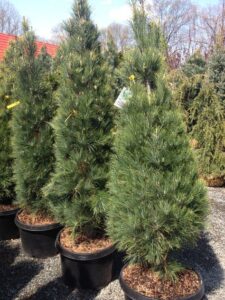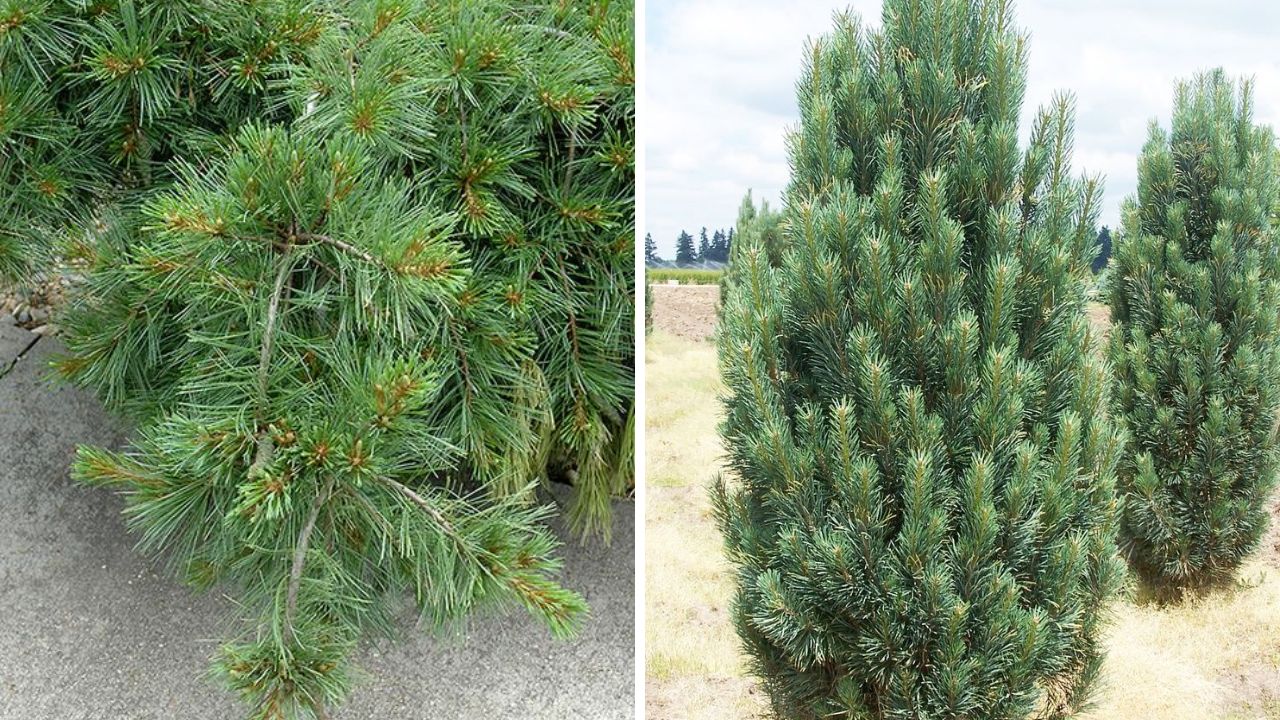The largest natural conifer in eastern North America is the Eastern white pine (Pinus strobus). This quickly spreading evergreen, which spans growth zones 3 through 8, is typically found as far north as Newfoundland and as far south as northern Georgia. It has long, velvety, blue-green needles. The eastern white pine has a maximum height of 80 feet and a maximum width of 40 feet.
The tree is shaped like a lovely, rounded pyramid. It may be cut into wedges and serve as a great shade tree and windbreak. The boughs are frequently used in outdoor Christmas decorations that use greenery, and the branches are highly valued for crafts and decorations.
Eastern white pine Overview

| Common Name | Eastern white pine |
| Botanical Name | Pinus strobus |
| Family | Pinaceae |
| Plant Type | Tree |
| Mature Size | 50-80 ft. tall, 20-40 ft. wide |
| Sun Exposure | Full, partial |
| Soil Type | Moist, well-drained |
| Soil pH | Acidic |
| Hardiness Zones | 3-8 (USDA) |
| Native Area | North America |
Eastern White Pine Care

The primary maintenance needs for cultivating an eastern white pine tree are as follows:
- Grow eastern white pine on soil with a low pH (sometimes known as “acidic soil”). A well-drained, medium-moisture soil is essential.
- In cool areas, plant your eastern white pine in full sun. But in warmer climates, put it in partial light.
- Before planting, amend compacted clay soils with compost.
- Eastern white pines require a lot of room. It is recommended to plant individual trees a minimum of 20 to 30 feet apart from other trees or bushes.
Light Requirements
At least four hours of direct sunlight every day is beneficial for this tree’s health. However, the climate is more appreciative of midday shade the hotter it becomes.
Soil and Potting
Eastern white pine prefers well-drained, acidic soil. The soil will cool if a heavy layer of pine needle mulch is placed over the root zone. In metropolitan settings where ozone and sulfur dioxide are prevalent in the soil, it may not function well.
Watering
When the tree is young, make sure it gets plenty of water; however, after it is established, it can tolerate somewhat dry soil as long as it is kept cool. It continues to be a happy specimen if provided roughly one inch of water each week.
Temperature and Environment
Extremely hot conditions are not ideal for Eastern White Pine. This tree likes its weather to be cool and muggy. It occasionally has trouble in the warmer end of its hardiness zone.
Fertilization
Feeding eastern white pine in the spring with an evergreen-specific high-acid fertilizer is recommended. Refer to the fertilizer label instructions for the precise amount.
Types of Eastern White Pine
The most common form to be planted is the species form, however, there are a number of excellent cultivars, particularly the dwarf varieties:
- ‘Nana’ and ‘Compacta‘ are two mounded dwarf varieties.
- ‘Blue Shag‘ is a compact form with blue-green needles.
- ‘Contorta’ is a variety of twisted, curled branches.
- ‘Fatigiata’ has a tall, columnar form with blue-green needles.
- ‘Pendula’ is a weeping form of eastern white pine.
- ‘Aurea’ is a variety of yellow needles.
Pruning
Whenever you see a branch that is damaged, dead, or infected, remove it. When pruning a tree for size or shape, do so during its dormant season in late fall, winter, or early spring.
Propagating Eastern White Pine

It is not too difficult to grow this tree from seed.
- Take mature, big cones and let them dry completely. Shake out the seeds from a cone after it’s brittle and dried.
- Plant them in a shaded place with wet soil, about 1/4 inch deep. To ensure that you don’t unintentionally weed them out or mow them down, make sure to indicate the spot.
- If there isn’t any rain, irrigate the soil to keep it moist. While young trees require time for germination and initial growth, they can be easily transferred to different areas once established.
- The trees grow rather quickly after they reach the size of young saplings.
Common Pests & Plant Diseases
Regrettably, a lot of illnesses and pests can harm eastern white pine. Many rust and blight diseases can occur; white pine blister rust is one that frequently kills the trees. Before planting an eastern white pine, be sure that this disease is not widespread in the area.
This tree can be attacked by white pine weevils, especially when it is still less than 20 feet tall. A curled, dead, or dying terminal leader and lustrous resin seeping from the tiny holes the weevils eat into the bark in the spring are signs that the pest is feeding on the tree.1. To stop the pest’s life cycle, the leader needs to be eliminated as soon as possible. Applying herbicides to huge trees can be challenging.
Common Problems With Eastern White Pine
When planting eastern white pine, a typical issue is that homeowners neglect to account for the tree’s mature size. Because of this, the tree soon outgrows its designated territory and starts to encroach on other plants, fences, decks, your house, etc. Pruning frequently will keep this enormous specimen more of a shrub than a tree, which is an option if you enjoy the foliage of eastern white pine but are unsure if you have enough room for it in your yard.

Pingback: Vanda Orchid Complete Guide To Grow And Care